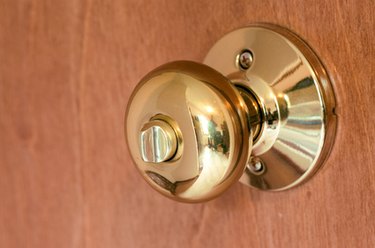
Things You'll Need
Phillips screwdriver
Slotted screwdriver
Metal file
Safety glasses
Hammer
Chisel
Power drill
Drill bit set
The strike plate is the piece of door hardware that attaches to the door jamb and receives the latch. Latches that don't fit properly into these plates will allow doors to rattle, or prevent them from closing. Thankfully, the door latches and knobs don't have to be moved to correct these problems. Adjusting the door strike plates will align latches.
Step 1: Tighten Mounting Screws
Tighten the mounting screws holding the strike plate with a Phillips screwdriver. Loose screws cause plates to sag, and latches won't meet securely. Close the door to see if secure screws correct the problem.
Video of the Day
Step 2: Examine the Action
Look at the scratch marks left on the strike plate by the latch to see if it meets the plate too high or low. Close the door from the inside and watch how the latch aligns with the plate if the door hardware is too new to show scratches.
Step 3: Remove the Strike Plate
Remove the door strike plate by loosening the two mounting screws with a Phillips screwdriver and file the upper or lower edge of the latch hole with a metal file if the latch is meeting slightly too low or high. Replace the plate and secure the mounting screws. Put on safety glasses and use a hammer and chisel to chip out any wood that shows through from behind the filed edge. Close the door to see if it latches.
Step 4: Bend the Tab to Allow for the Latch
Bend the tab on the plate that folds into the hole forward with a slotted screwdriver to make room for the latch of a door that won't catch if the plate is seated too far inward. Close the door to check the repair.
Step 5: Move the Door Strike Plate if Necessary
Remove the door strike plate and change its location on the door jamb if the misalignment is too severe to correct otherwise. Move the plate up, down, forward or to the inside as necessary to accommodate the latch. Draw pencil marks around the outside perimeter of the plate, the latch hole and the screw holes.
Step 6: Chip Away Some of the Wood
Put on safety glasses. Remove 1/16 of an inch from the surface of wood on the door jamb inside the perimeter pencil mark that wasn't already mortised for the plate by placing the sharp edge of a chisel against the pencil mark. Hold the handle at a 30-degree angle to the door jamb and tap it with a hammer to chip away the wood inside the mark. Hold the plate against the jamb to see that the outside face is flush with the jamb. Chisel away more wood as necessary to fit the plate.
Step 7: Drill Pilot Holes
Put on safety glasses and drill pilot holes for the mounting screws at the screw hole pencil marks. Use a drill bit that is slightly narrower than the diameter of the screws.
Step 8: Chisel and Hammer
Put the sharp edge of a chisel against the latch hole mark and tap the handle with a hammer to remove the wood necessary to increase the latch hole for the new plate location. Replace the latch, tighten the mounting screws and close the door to check the adjustment of the door strike plate.
Video of the Day